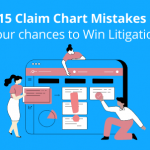I’m going to enforce my patent rights” said Joey to Ross. Joey and Ross, both inventors and long-time friends had met for drinks in a nearby pub. Recently, Joey had been struggling, mainly because a large company ADC Corp. started manufacturing a product which is quite similar to Xene, Joey’s bestselling patented product. Things were getting worse for Joey as sales of ADC’s product – which was priced really low – were soaring and Xene’s sales were getting affected. Joey even tried to reach out to ADC Corp. to inform them of the possible infringement but he didn’t receive a response from anyone. Frustrated, Joey had finally decided to pull out the big guns. He decided to enforce his patent rights.
“You’re doing the right thing. Have you hired an attorney yet? Also, did you get a claim chart generated?” Ross asked Joey.
Joey nodded and his face portrayed mix feelings of acknowledgment and confusion. He had scheduled an appointment with one of the best patent attorneys in the county for the coming week. He wasn’t sure what a claim chart was though. A prolific inventor by all means, and a holder of a significant patent portfolio, Joey never had the chance to enforce any of his patents, as he merely accumulated IP to protect his inventions while having the freedom to operate without the fear of infringing anyone else’s patents.
Understanding Joey’s clear lack of knowledge on claim charts, Ross decided to step up to the occasion. What follows next is Claim chart 101, in the words of Ross.
What is a Claim Chart?
A claim chart is used to showcase how a product (or a service) has infringed on a patent.
It started making sense to Joey as he nodded in acknowledgment. Ross continued.
“Normally, to prove infringement, the patent owner/plaintiff must show that the product or service in question infringes on every portion of the claims. Claim charts solve this problem as they break down even very complicated claims into easily read arguments that both parties can use when deciding a case.”
“In your case, Joey, the claim chart when generated would showcase how ADC Corp’s product infringes on your patent. If you had approached ADC Corp with a claim chart in the first place, you would have reached some conclusion by this point in time.”
Joey had a clear understanding of claim charts by this moment. But then suddenly, a confused look appeared all over his face. Joey blurted, “So you’re saying, claim charts can be used out of litigation too. I thought that claim charts are used in patent litigation.”
With a smile, Ross continued, “It is true that claim charts are majorly used in patent litigation. But they also have other applications. In fact, they are really underrated. Would you believe me if I said, Claim charts can help you make money?”
“Enlighten me”, quipped Joey.
“Wouldn’t it be better if I took over from here?” asked Vincy, who had been working as an infringement analyst for years and clearly had more experience with the subject at hand. Ross and Joey, both imaginary characters, politely nodded, as Vincy took over herself to explain the different scenarios where claim charts could be used.
How can Claim Charts be used in different scenarios?
Well, most of us believe that claim charts can be used to show product overlap solely. But there are more scenarios where claim chart could be used as a valuable tool and would actually reap profits. Here are a few scenarios in which claim charts can be used.
- If you are at the buying end – It is generally considered as the responsibility of patent owner/seller to show the infringement potential of the patent. But how can you be sure that the facts presented by the seller are true when you are at buying end?
In this case, a claim chart can be useful for cross-checking the infringing products for the patent you are planning to buy. For example, preparing a claim chart to identify how dissimilar or similar the product and patent is. The example below of a claim chart showcases the similarity between a patent and a product.
- If you are a Licensee – Are you sure that licensing fee or amount you are investing in the patent is fair? In this case, a claim chart can be used for identifying the following parameters:
- Product coverage or number of products in the market which overlap the patent;
- The degree of overlap – Whether the patent completely overlaps the products or there is 90% overlap (this would require in-depth analysis including file history of the patent, clarifying the scope of elements, et cetera);
- The market of the patent (based on the number of products and degree of overlap).
The above factors can raise or drop the bar of investment in the patent. Accordingly, the terms for license/acquisition can be decided.
Below is an exemplary slide from chart showcasing product coverage of a patent –
- Understanding Competition – If you are facing a tough competition in the market and want to know where your competitor stands, Claim chart can be used to identify the similarity between patents filed by competitor companies.

- Are you in a litigation fix or want to invalidate a patent? Claim chart can be used to invalidate a patent showing mapping with literature existing prior to the patent. This will render the patent novelty as weak. The prior art references can be picked from patents as well as from products and can be used in your favor.
- If your patent has a futuristic invention and a big company announces to launch similar product – A claim chart can be prepared to show how the patent invention relates to the product and what could be the future market for it. This might help you make money even before the product is launched. That big company might get interested to invest in your patent to make their IP strong before launching the product.
- Want to countersue? Claim chart can be used to identify how your best patent overlaps the biggest product of the other party.
This and lot more. There are multiple scenarios where claim charts could be used, each to your advantage, which would help you generate money in the long run, irrespective of the situation.
Claim charts are a powerful tool, which can always be customized according to the needs of the user and should be a part of your strategy kit when it comes to your patent portfolio. As they say it, a great tool is more powerful than a dozen clever tactics.
Do you want us to help you prepare a powerful claim chart?

Authored by: Vincy Khandpur, Team Lead, Infringement and Anjali Chopra, Senior Business Analyst, Market Research.













